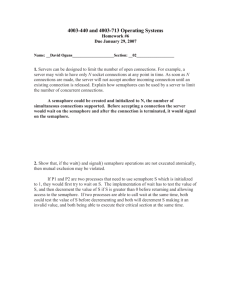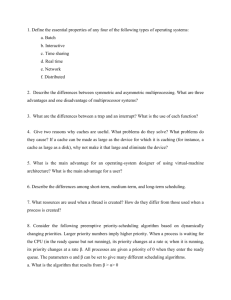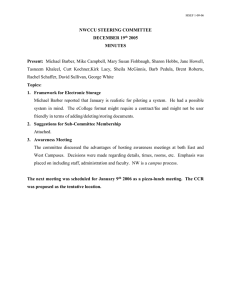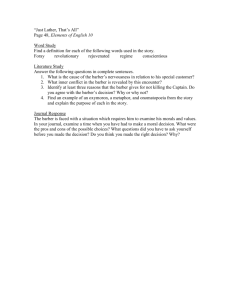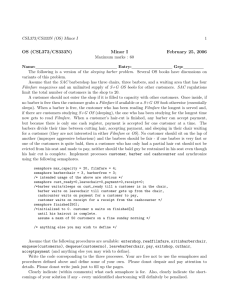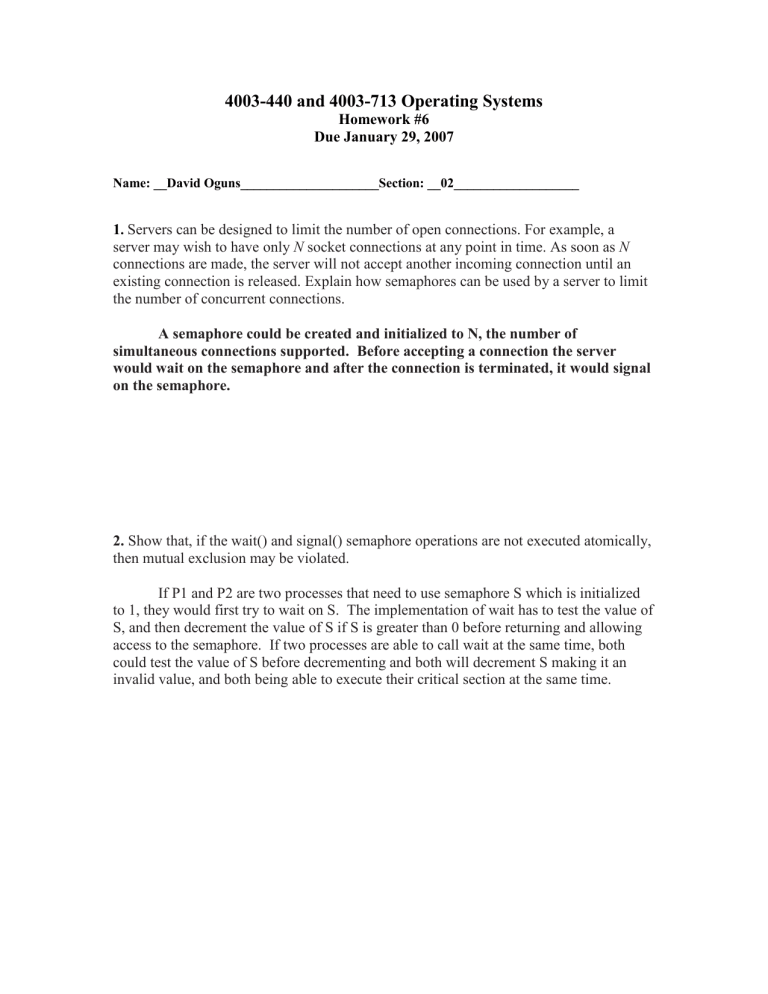
4003-440 and 4003-713 Operating Systems
Homework #6
Due January 29, 2007
Name: __David Oguns_____________________Section: __02___________________
1. Servers can be designed to limit the number of open connections. For example, a
server may wish to have only N socket connections at any point in time. As soon as N
connections are made, the server will not accept another incoming connection until an
existing connection is released. Explain how semaphores can be used by a server to limit
the number of concurrent connections.
A semaphore could be created and initialized to N, the number of
simultaneous connections supported. Before accepting a connection the server
would wait on the semaphore and after the connection is terminated, it would signal
on the semaphore.
2. Show that, if the wait() and signal() semaphore operations are not executed atomically,
then mutual exclusion may be violated.
If P1 and P2 are two processes that need to use semaphore S which is initialized
to 1, they would first try to wait on S. The implementation of wait has to test the value of
S, and then decrement the value of S if S is greater than 0 before returning and allowing
access to the semaphore. If two processes are able to call wait at the same time, both
could test the value of S before decrementing and both will decrement S making it an
invalid value, and both being able to execute their critical section at the same time.
3. The Sleeping-Barber Problem. A barbershop consists of awaiting room with n chairs
and a barber room with one barber chair. If there are no customers to be served, the
barber goes to sleep. If a customer enters the barbershop and all chairs are occupied, then
the customer leaves the shop. If the barber is busy but chairs are available, then the
customer sits in one of the free chairs. If the barber is asleep, the customer wakes up the
barber. Consider this as an instance of the Producer-Consumer problem. Identify the
producer(s), the consumer(s) and the contents and maximum size of the bounded queue.
Write the pseudocode to coordinate the barber and the customers.
The producers of this problem are the customers. They produce work for
the consumer, the barber. The contents of the queue for the consumer are
the consumers sitting in the n chairs. The maximum size of the queue is n.
PSUEDOCODE: Initialize S to n.
Producer:
while(true)
//keep the consumers coming
{
wait(S);
//get hair cut
}
Consumer:
while(true)
{
if(S < n)
{
//do haircut
signal(S);
}
}
4. Discuss the tradeoff between fairness and throughput of operations in the readerswriters problem. Propose a method for solving the Readers-Writers problem without
causing starvation.
In the readers-writers problem, the writer(s) may be starved if the readers are
constantly reading from the resource. They will keep the semaphore tied up and the
writer will never have an opportunity to write. This is unfair for the writer but
optimal for reader throughput since any number of readers can read at the same
time without any negative effects. To be more fair to the writer(s), it should create a
queue when they need to read and wait for only the currently reading readers to
complete and the semaphore to be available. Any new readers that wish to read
from the semaphore are placed behind the write in the queue. After the readers are
complete, the writer takes its turn with the semaphore. After it is done, any and all
of the waiting readers can do their work.
This solution also solves a potential coherency problem with synchronized access to
data where a read operation may come after a write and thus reads old data.
5. Write a the pseudocode for a monitor that implements an alarm clock that enables a
calling program to delay itself for a specified number of time units (ticks). You may
assume the existence of a real hardware clock that invokes a procedure tick in your
monitor at regular intervals.
Monitor AlarmClock
{
condition self;
int delay;
void pause(int time)
{
delay = time;
self.wait();
}
void tick(int delta) //assuming delta is the amount of time that has passed
{
delay -= delta;
if(delay <= 0)
self.signal();
}
}
